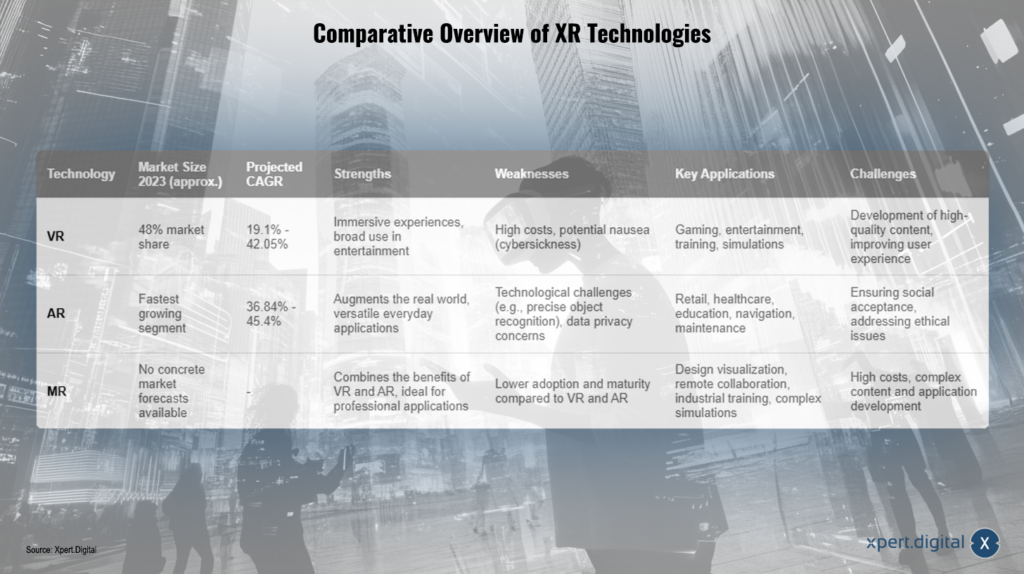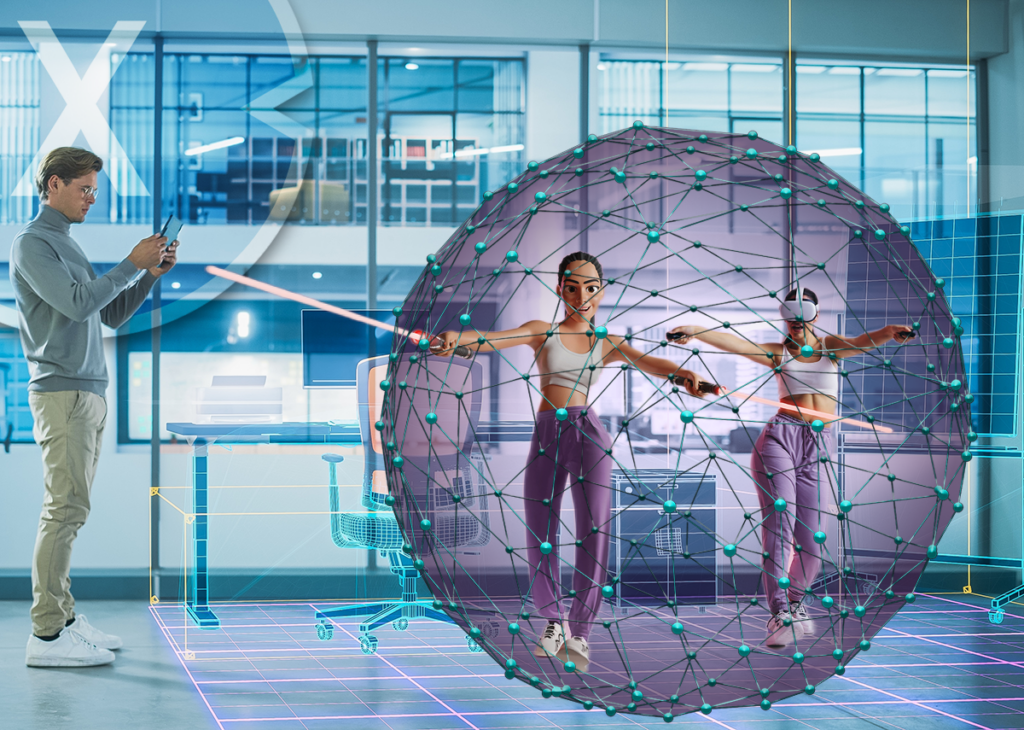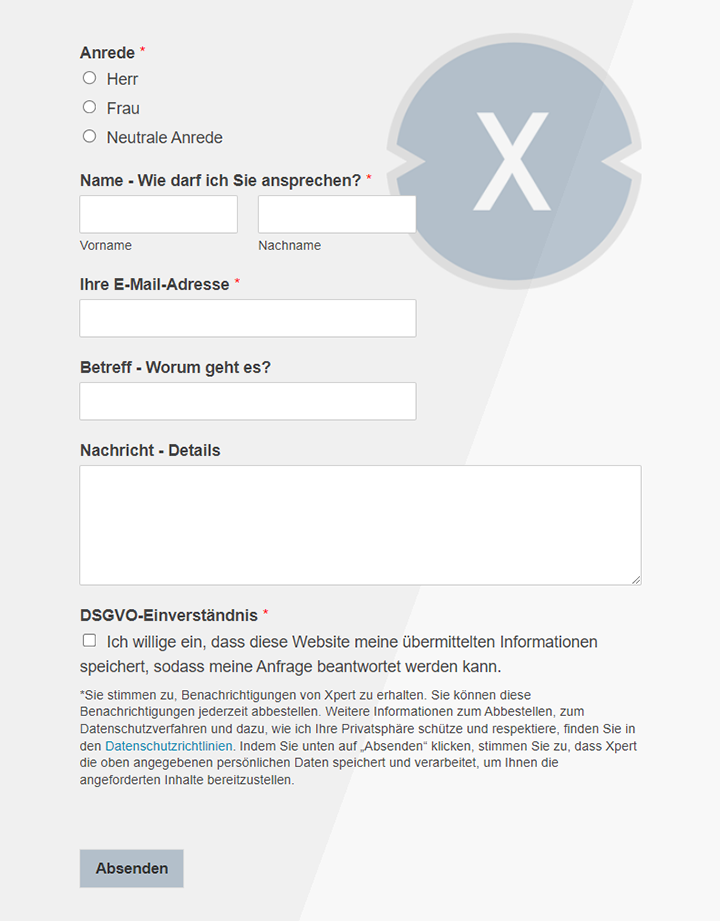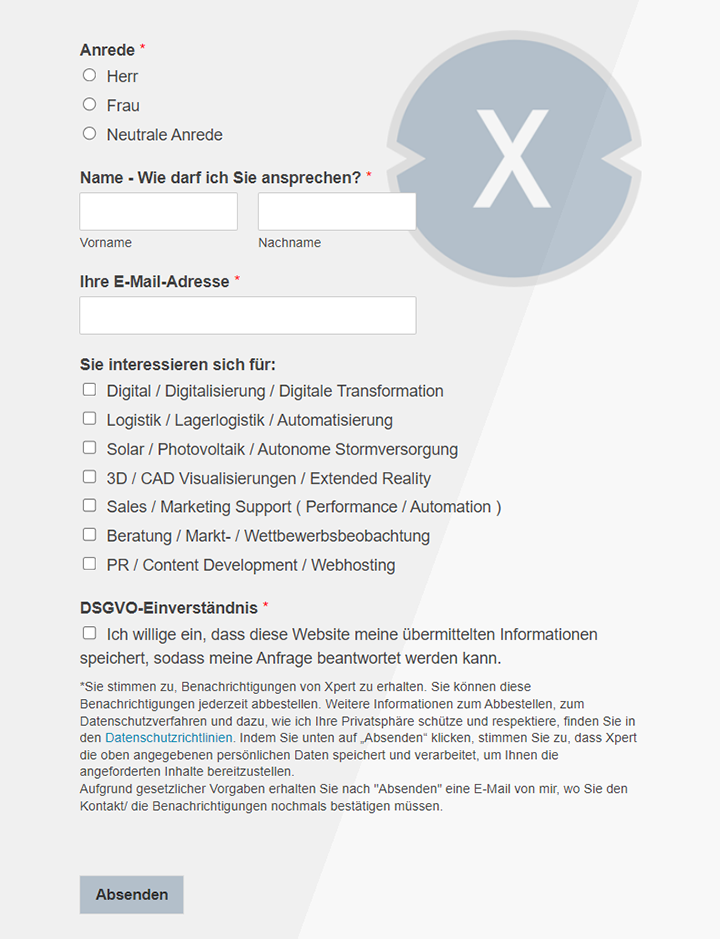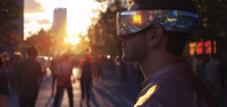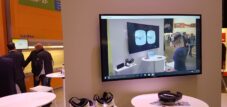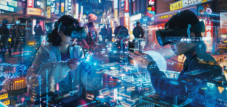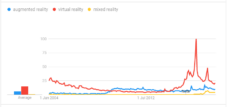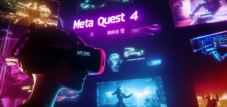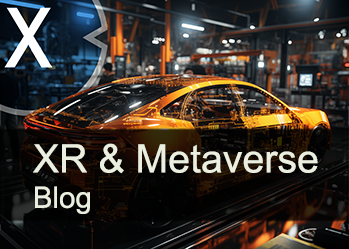VR, AR and MR in a global comparison: Regional focuses, technical milestones and current XR market developments
Xpert pre-release
Language selection 📢
Published on: January 15, 2025 / Update from: January 15, 2025 - Author: Konrad Wolfenstein

VR, AR and MR in a global comparison: Regional focuses, technical milestones and current XR market developments - Image: Xpert.Digital
Changing technology: Why VR, AR and MR will change the world together
Virtual, augmented or mixed reality? A global look at opportunities and challenges
“Extended Reality” (Extended Reality, or XR for short) summarizes technologies that digitally expand our perception of the real world or even completely replace it with virtual scenarios. The most important facets include virtual reality (VR), augmented reality (AR) and mixed reality (MR). While VR immerses the user in completely virtual worlds, AR combines the real environment with displayed information or objects. MR goes one step further and combines both spheres, allowing users to interact with virtual and real elements in real time.
The rapid development of these technologies opens up a wide range of possible applications in almost all areas of life: from realistic simulation in medicine to interactive marketing concepts in retail to virtual business meetings that overcome geographical distances. Companies worldwide are investing massively in research, development and infrastructure. Tech giants from the USA and China are racing for the leading position, while countries such as South Korea, Japan and Germany are pushing forward pioneering pilot projects. Despite all the opportunities and potential, technical hurdles such as expensive hardware and a lack of standardization must be overcome. At the same time, ethical and social questions are moving more into focus: How do you design data protection? How do you prevent manipulation? And what social impact does it have when reality and virtuality increasingly blur?
One thing is certain: XR is more than a short-lived trend. Virtual reality, augmented reality and mixed reality are here to stay - and they will fundamentally change our working world, our everyday life and our leisure time in the coming years.
Suitable for:
What is meant by “augmented reality” (XR)?
The term “augmented reality” (XR) encompasses technologies such as virtual reality (VR), augmented reality (AR) and mixed reality (MR). What all three variants have in common is that they seamlessly embed digital content into our physical environment or allow us to completely immerse ourselves in virtual worlds. This changes or expands our perception, which enables diverse applications in entertainment, industry, medicine and many other areas.
What are the differences between virtual reality (VR), augmented reality (AR) and mixed reality (MR)?
- Virtual Reality (VR): Here you are completely immersed in a computer-generated world. A headset and special controllers or sensors enable an immersive experience that completely blocks out the real environment.
- Augmented Reality (AR): Additional digital information is displayed in real time in the real environment, often via smartphones or AR glasses. Displays of navigation instructions, interactive elements or product information are typical.
- Mixed Reality (MR): Here, the real and virtual environments merge even more closely, so that virtual objects are spatially embedded in the field of vision and interactions with both levels are possible. MR combines the advantages of VR and AR by realizing both immersion and embedding in the real environment.
What areas of application does virtual reality (VR) have beyond gaming and entertainment?
- Training and simulation: VR enables cost-effective and safe training scenarios for complex processes, for example in medicine, military or aerospace.
- Therapies and rehabilitation: In psychology, VR is used for confrontation therapy (e.g. against fear of heights or arachnophobia), while in rehabilitation movement sequences can be trained in a playful way.
- Virtual meetings and events: Companies use VR for conferences, seminars and collaboration across national borders.
- Culture and travel: Virtual museum visits, city tours or exotic travel destinations can be made more accessible with VR - even for people with limited mobility.
What are the current challenges with VR?
- Cost: High-quality VR headsets are often still expensive.
- Comfort: The devices can be heavy and unwieldy, and some users also suffer from “cybersickness” (nausea, dizziness).
- Content: The range of high-quality and varied applications must continue to grow.
- Acceptance: For VR to be successful in the long term, the technology and content must be so convincing that broad user groups feel addressed.
Why is augmented reality (AR) growing so quickly and what are the most important areas of application?
AR has the advantage that almost every modern smartphone has a camera and sufficient computing power to offer basic AR functions. This means that the barrier to entry is low for many users. Typical fields of application are:
- Retail and marketing: Virtual trying on products, 3D display of furniture in your own home or interactive advertising campaigns.
- Education: Clear knowledge transfer, e.g. B. by displaying historical scenes or anatomical representations directly in the classroom.
- Industry and trade: AR glasses enable maintenance and repair instructions to be in the field of vision, reducing sources of error and accelerating work processes.
- Navigation and outdoor experiences: Displays of signposts, information about sights or danger spots in real time increase comfort and safety when traveling.
What is Mixed Reality (MR) and why is it considered particularly forward-looking?
Mixed Reality combines the strengths of VR and AR. Users can integrate virtual 3D objects into their real environment and interact with both levels. This enables applications such as:
- Design visualization: Architects and engineers can represent planned models or components realistically.
- Remote collaboration: Teams distributed worldwide work together on virtual 3D projects in an MR environment.
- Interactive training and simulations: Medical procedures or complex work steps can be trained realistically.
- However, MR requires powerful hardware and software, which is why it is currently used primarily in specialized areas.
Which countries are playing a leading role in the development and dissemination of XR technologies?
- USA: Large technology companies such as Microsoft, Apple and Google are investing heavily in AR and MR solutions; VR benefits from a thriving gaming industry.
- China: Relies on rapid growth, 5G and future 6G expansion as well as an open-minded consumer base. Government and private sector are advancing VR/AR in education, health and entertainment.
- Japan: Early pioneer in the gaming sector, now increasing use of XR in medicine, tourism and manufacturing.
- South Korea: Very tech-savvy country with promotion of 6G and a strong focus on gaming, e-sports and military cooperation.
- Indonesia: Above all, takes advantage of the rapidly growing smartphone penetration and mobile gaming passion for AR applications.
- Brazil: Dynamic start-up scene with pilot projects in agriculture, education and industry.
- Europe (with examples from France and Germany): EU funding programs strengthen VR, AR and MR; Industry 4.0 plays a major role in Germany, while France relies on immersive technologies in research and culture.
Which factors are crucial for the success of VR, AR and MR?
- Technological development: Powerful processors, high-resolution displays, precise sensors and low latencies are basic requirements.
- Content and applications: Without convincing apps, games, learning and work applications, the potential remains unused.
- Costs and accessibility: If hardware prices fall and it becomes suitable for the masses, distribution increases enormously.
- Ease of use: User-friendly devices and intuitive operation are crucial to reducing barriers to entry.
- Social Acceptance: Data protection, privacy and society's willingness to adopt new technologies are key factors.
- Ethical and legal aspects: Rules to protect against abuse, misinformation and surveillance are important to create trust in XR.
Why is there often talk of a “coexistence” of VR, AR and MR instead of a single dominant technology?
VR, AR and MR each have specific strengths and areas of application. VR impresses with intensive immersion (e.g. in gaming and simulation), AR scores with contextual information in real time (e.g. navigation, retail), while MR is particularly helpful with interactive 3D models and complex industrial tasks. Instead of displacing each other, they complement each other and are likely to continue in parallel. In the long term, mixed forms could develop in which headsets or systems flexibly switch between VR, AR and MR modes.
What role does the “Metaverse” play in this context?
The Metaverse represents a possible future digital world in which virtual and real areas merge. VR, AR and MR are the key technologies to realize this vision. Here people could go into immersive environments, work, learn, shop or communicate. At the same time, the metaverse places high demands on:
- Standardization (compatibility of devices and applications),
- Content (breadth and quality of the offer),
- Privacy and security (protection of personal information) and
- Infrastructure (fast networks such as 5G/6G and sufficient computing power).
Suitable for:
- XR technology: The Metaverse Winter – Rethinking, re-immersing and setting the right goals with Extended & Virtual Reality
- Metaverse Development: A Comparison Between Consumer, Customer, E-Commerce (V-Commerce) and Industrial Metaverse
What challenges need to be solved so that XR technologies can be used even more widely?
- Standardization: Uniform technical standards make compatibility and operation easier.
- Diverse content: XR can only convince the mass market with a wide range of useful, exciting or cost-effective solutions.
- Data protection and security: Users must have trust in the technology, for example through clear regulations for the handling of data and measures against manipulation or misuse.
- Infrastructure: A smooth, low-latency XR experience requires high-performance Internet connections and energy-efficient systems across the board.
- Cultural acceptance: Skepticism and possible social impacts (e.g. digital detox) must be discussed and addressed responsibly.
How do experts see the economic importance of XR?
Many forecasts suggest that XR technologies will create enormous economic value in the coming years. From healthcare to education to Industry 4.0, VR, AR and MR could collectively generate hundreds of billions to well over a trillion US dollars in added value. There are also new job profiles and specializations (XR designers, metaverse architects, etc.) that offer significant job potential.
What is the conclusion regarding the future of VR, AR and MR?
- A single “winning technology” is unlikely: VR, AR and MR will coexist and cross-fertilize.
- Each system has its strengths: VR for immersion, AR in everyday life, MR for sophisticated industrial solutions.
- Technical advances, falling costs and more content will promote distribution.
- At the same time, the Metaverse is emerging as a higher-level platform in which these technologies merge.
- Those providers and users who are innovative, invest early and take ethical and social factors into account are successful.
Overall, XR is expected to become an integral part of the digital transformation that will have a lasting impact on our working world, our everyday life and our leisure time.
🗒️ Xpert.Digital: A pioneer in the field of extended and augmented reality
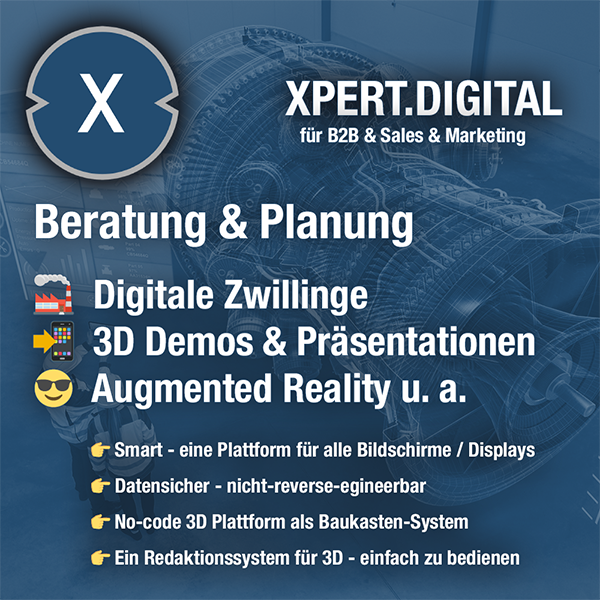
We are there for you - advice - planning - implementation - project management
☑️ SME support in strategy, consulting, planning and implementation
☑️ Creation or realignment of the digital strategy and digitalization
☑️ Expansion and optimization of international sales processes
☑️ Global & Digital B2B trading platforms
☑️ Pioneer Business Development
I would be happy to serve as your personal advisor.
You can contact me by filling out the contact form below or simply call me on +49 89 89 674 804 (Munich) .
I'm looking forward to our joint project.
Xpert.Digital - Konrad Wolfenstein
Xpert.Digital is a hub for industry with a focus on digitalization, mechanical engineering, logistics/intralogistics and photovoltaics.
With our 360° business development solution, we support well-known companies from new business to after sales.
Market intelligence, smarketing, marketing automation, content development, PR, mail campaigns, personalized social media and lead nurturing are part of our digital tools.
You can find out more at: www.xpert.digital - www.xpert.solar - www.xpert.plus



